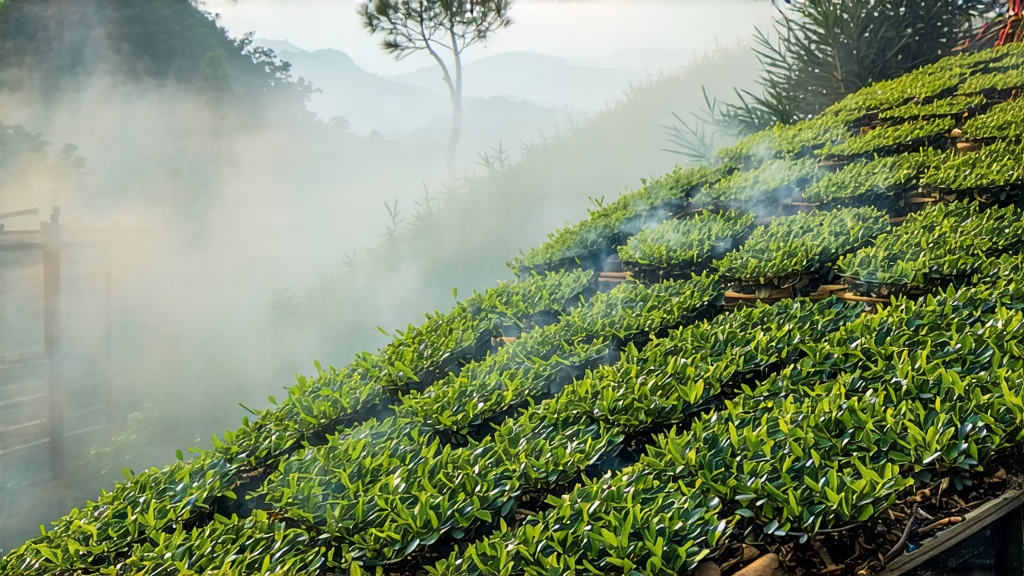
Lapsang Souchong, known in China as Zheng Shan Xiao Zhong, is the oldest recorded black tea on earth and the progenitor of every red-black leaf that followed. Its story begins in the early 17th century among the sheer cliffs of the Wuyi Shan, a UNESCO dual World Heritage site straddling Fujian’s misty north. Here, where granite spires rise above the Nine-Bend River, Buddhist monks and tea farmers first discovered that allowing freshly picked leaves to oxidise fully before firing produced a liquor so crimson it resembled dragon’s blood. European traders who entered the port of Xiamen in 1640 christened the innovation “Bohea,” a corruption of “Wuyi,” and by 1669 the East India Company was auctioning chests of it in London for prices higher than silver.
The name itself encodes geography and craft. “Xiao Zhong” means “small cultivar,” a reference to the diminutive tea bushes that hug the rocky crevices; “Zheng Shan” restricts authenticity to the original 600–1,200 m micro-zone within Tongmu Guan, a protected nature reserve where outsiders must obtain special permits to enter. Outside this 48 km² enclave, similar leaves are called “wai shan” (outer mountain) and lack the perfume of resin and longan that defines the true tea.
Two distinct styles survive today. The traditional craft version, still hand-made by a handful of Tongmu families, is withered over embers of local Masson pine, rolled gently, oxidised 80–90 %, then hot-smoked in bamboo baskets suspended above slow-burning pine logs. The smoke is not a flavouring added later; it is the drying medium, permeating the cell walls until the leaf carries a memory of the forest. The modern “unsmoked” or “fruit-style” Lapsang, invented for the contemporary Chinese palate, omits the final smoking, yielding a maltier cup reminiscent of caramelised longan and dried lychee. Both styles share the same cultivars—Xingcun Xiaoye, Wuyi Qizhong, and the rare wild Caicha—but diverge dramatically in aroma.
Harvest follows the lunar calendar. The first plucking, Mingqian, occurs two weeks before Qingming festival when nights are still cool and aphids absent. One bud with two leaves, the “sparrow’s tongue,” is snipped between thumb and forefinger before 10 a.m. while dew lingers. A master picker can gather only 5 kg of fresh leaf in a day; that reduces to 1 kg of finished tea, enough for roughly 200 gongfu sessions.
Withering is the soul step. In Tongmu, the leaf is laid on bamboo screens set into wooden racks above squat, waist-high rooms heated by pine embers. The temperature hovers at 28 °C for the first two hours, then climbs to 35 °C while artisans shuffle the trays every fifteen minutes. Moisture drops from 74 % to 58 %, and the grassy volatiles of fresh leaf give way to precursors of honey and smoked peach. Oxidation follows in deeper bamboo trays lined with wet cloth; the leaf is turned every thirty minutes for four hours while the colour shifts from jade to copper to obsidian. The moment the edge of a leaf stains mahogany, the master calls “ting” and rushes the trays to the charcoal pan.
Firing employs the lowest possible heat—85 °C at first—so the leaf does not blister. The crafter’s bare hand becomes the thermometer, sweeping through the leaves until they feel like warm silk. Once the moisture falls below 7 %, the smoking begins. Pinewood is split to finger-thin slivers, stacked into a pit, and ignited so that only aromatic smoke, not flame, rises. Bamboo baskets holding the tea are stacked three tiers high; the smoke must be cool enough that a hand held at basket level feels no hotter than a baby’s breath. Eight hours later the leaf is glossy, black, and impregnated with guaiacol and syringol, the molecules that translate into campfire sweetness.
To brew Lapsang Souchong gongfu style, begin with soft water at 90 °C. Pre-warm a 120 ml gaiwan or Yixing zi-sha teapot aged with black tea seasoning. Use 5 g of leaf—about two heaping teaspoons—rinsed for three seconds to